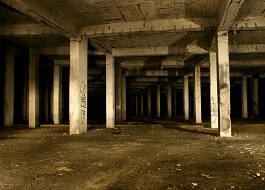
Prague will announce a tender for the renovation of the underground of the former Stalin monument
 |
"The condition of the interior is in a state of emergency, and we cannot allow anyone in there. It looks catastrophic," Krnáčová said. While searching for a location for a modern art gallery, the city had several sites in mind according to her. However, it ultimately decided on the former monument, which, according to Krnáčová, the city would have to either demolish or renovate anyway.
The study that will serve as the basis for the specific project will be created by the NG. The material will determine what will be in the underground or who will be the program bearer. According to Fajt, it will be based on an earlier construction and technical study. Based on the study created by the NG, preparation for the actual project will begin. The NG will start working on the study immediately after signing the memorandum with the capital city.
A cultural-educational center, which the NG is tentatively calling a contemporary art center, is to be established in the space. It aims to support the younger generation of artists and simultaneously recall the history of the monument and totalitarian Czechoslovakia. "We will only start dealing with the content then. The location has such enormous symbolic value that it needs to be remembered. What that underground served for will not be forgotten," Fajt said. In preparing the study, the NG will collaborate with Prague 7, the Institute of Planning and Development, and conservationists.
The underground will be divided into four parts. One of them will be the main exhibition hall, then there will be space for presenting the history of the site, including unrealized proposals for the development of the Letná edge, and another hall should present the communist totalitarian regime. The last part would serve the street art community. The ceiling slab will be repaired. According to Fajt, nothing will be created on the surface; all work will take place underground.
It is unclear when the new gallery will be established. However, according to Fajt, if no complications arise, it could take place within three to five years.
The city government's plans are criticized by the leadership of Prague 7. "It is an unacceptable approach, and it is sad that the NG is involved in this. After the elections, there will be much to rectify because any repair of this place must be maximally sensitive, well-discussed, and solely based on an international architectural competition," Mirovský stated. "It all seems that the ANO movement is trying to build a monument to the mayor at the last minute," stated the mayor of Prague 7 Jan Čižinský (Praha Sobě) at the beginning of August. Krnáčová rejected the criticisms from Prague 7 today.
One of the most bizarre European communist monuments was unveiled after six years of construction in 1955, when the era of worshiping the Soviet leader, who died in 1953, was approaching its end. In February 1956, Stalin's successor Nikita Khrushchev condemned the cult of Stalin's personality at the 20th Congress of the Communist Party of the Soviet Union. Despite this, Prague communists decided to remove the 22-meter-high monument only in the early 60s.
In the early 90s, cultural events were held in the spaces inside the pedestal. The largest was the exhibition Totalitarian Zone, during which Radio 1 initially began to pirate broadcast from the monument's depths, then as Radio Stalin.
The English translation is powered by AI tool. Switch to Czech to view the original text source.
0 comments
add comment
Related articles
0
26.09.2019 | Prague will apparently partially reopen the area around the Stalin monument
0
05.12.2018 | The gallery in the base of the former Stalin monument in Prague will not be
0
07.09.2018 | Fajt: The appearance of the space under Stalin will be determined by an architectural competition
0
08.08.2018 | Possible modifications of the former Stalin monument at Letná face criticism
0
25.10.2017 | Under the former monument to Stalin, an exhibition on the totalitarian regimes of the 20th century will be established
0
13.07.2016 | Svah pod Letnou could be transformed into an exhibition hall





